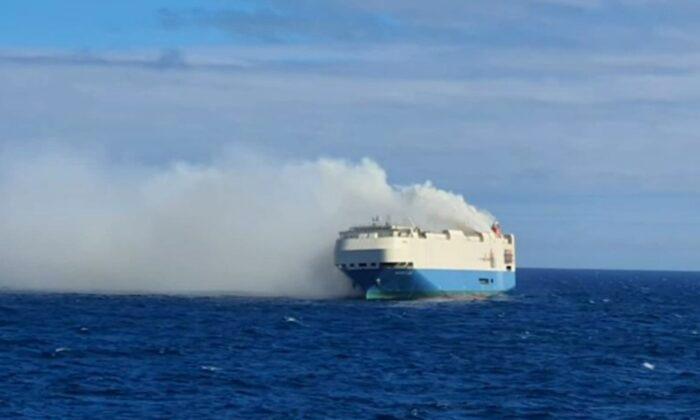The fire aboard a cargo ship carrying electric cars off the Azores islands is under control and is being put out, according to a Feb. 22 statement from Portuguese authorities.
The flames are no longer visible from the outside and the ship is now stable, they said.
The damaged vessel is expected to be towed across the mid-Atlantic to the Bahamas.
The blaze, which began on Feb. 16 on the Felicity Ace, has burned for six days near Portugal’s Azores islands leaving the vessel adrift.
The 200-meter-long (650-foot-long) Panamanian-flagged vessel, was on its way from Emden, Germany to the United States.
The 22 crew members on board were evacuated the same day the fire broke out by a Portuguese air force helicopter with no one harmed.
There were some 3,900 vehicles on the cargo ship, including Porsches, Audis, Volkswagens, and Bentleys.
Volkswagen has provided not details on the number of cars on board, Bentley confirmed that 189 of its cars were on the vessel, while Porsche said it had about 1,100 of its models on the ship.
Portuguese authorities do not have access to the ship’s manifest, so it is unknown how many vehicles are on board or what models they belong to.
According to Captain Joao Mendes Cabeças, the Port of Horta harbormaster on the island of Faial, the lithium-ion batteries from electric vehicles on board the vessel were possibly responsible for “keeping the fire alive.”
The cause of the fire is not known, but he said suspicion has fallen on water sensitive lithium batteries in the electric vehicles.
“We know from what the captain told us that there were a lot of electric vehicles on board, as well as non-electric vehicles,” said Cabeças.
The harbormaster said that the fire broke out on a cargo deck where the vehicles were stowed, but when the alarm went off, there was already too much smoke to make out where the blaze had started.
Two ocean-going tugboats with firefighting equipment were needed to hose down the hull in order to cool it, as it was too dangerous to go on board after fire spread close to the ship’s fuel tanks, said Cabeças.
Firefighters could not use water as it would add weight to the ship, rendering it more unstable and because water does not stop lithium-ion batteries from burning, he added.
Two more tugboats are expected to arrive by the end of the week and a salvage crew hopes to get aboard the ship on Feb. 23 to hook up a tow line.
The Felicity Ace has a cargo capacity of more than 17,000 metric tons (18,700 tons) of cargo and can typically fit thousands of vehicles on the multiple decks in its hold.
The ship’s fuel tanks hold 2,000 metric tons (2,200 tons) of fuel and 2,000 metric tons (2,200 tons) of oil.
There is currently no threat of pollution, said Cabeças, and the flame retardant being hosed on the side of the vessel will prevent runoff from the lithium batteries from going into the sea.
The fire is the latest disaster in a string of setbacks to befall the auto industry, after the pandemic-related lockdowns led to a shortage of components and disruptions to international trade routes.
Although it will be months before the cause of the blaze is known, the incident on the Felicity Ace is raising questions on how to safely transport electric vehicles in the future.





